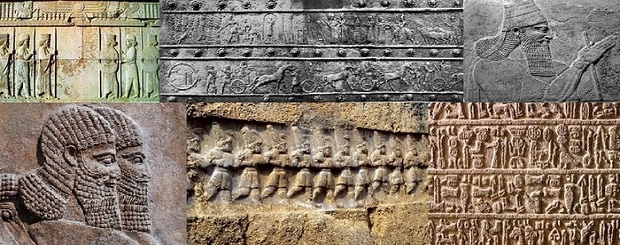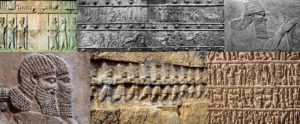
Art-A-Tsolum – The Term “Urartu” Originated From A Linguistic Error
May 13, 2019 Antiquities: Art-A-Tsolum – PREVIOUS ARTICLE:
In the 20th century, many propagandists from history (as I call such historians) questioned the work of Movses Khorenatsi, which no one has considered legendary and unreal in world historiography until the end of the 19th century. I am talking mainly about the first chapter of Khorenatsi’s “History of Armenia” based on the works of ancient Syrian historian Mar Abas Katina.
Moreover, the world got acquainted with the history of Armenia through history textbooks, in which the origin of the Armenian people and the state was presented according to Movses Khorenatsi. Consequently, no one has questioned that Armenians had been natives of the Armenian Highlands.
The basis for doubts about the veracity of Khorenatsi’s work’s first chapter, which talked about the origin of the Armenian people, was the book “Comparative Linguistics” published in the late 19th century. The hypothesis of the Indo-European origin of the Armenian language expressed in it gave rise to the problem of the location of the ancestral homeland of the Indo-European peoples. In other words, it implied that the Armenians have arrived in Armenian Highlands rather than have originated there.
And although this theory had a short life, to this day, historians from politics are trying to impose it on the world. And interestingly, the basis of such a ridiculous hypothesis was a small linguistic error. But let’s talk about everything in order.
As is often the case, simple human curiosity served as a stimulus for science. In 1802, German scholar and traveler Carsten Niebuhr published an ancient Parthian cuneiform inscription found in 1621 in Persepolis. By coincidence, a teacher at a school in the German town of Münden Georg Friedrich Grotefend and his friend have come across this cuneiform inscription.
A short discussion of Niebuhr’s publication by the two linguists ended with a bet of several bottles of beer on whether Georg Grotefend could decipher this cuneiform with its unfamiliar writing system or not. Georg Grotefend won the bet, not only winning beer but also becoming the author of his first sensation.
25 years later (in 1827), Edward Schulz was seconded to the city of Van in the Ottoman Empire (Western Armenia) by the French Asiatic Society. The task of Schulz was to study the somewhat poetic narration of Movses Khorenatsi about the role of Assyrian queen Semiramis in the construction of the city of Van.
After his death, Clayton, a famous British cartographer and explorer, arrived in Van. He also conducted excavations in Dzoravank fortress. Later, Garegin Srvandztiants wrote about the structures found during the excavations, with a wide variety of interior spaces ranging from ceremonial halls to vaulted hiding places. Buildings and many valuable items were also found.
“Many of them were excavated by local peasants, acquired by famous people in Van, and then secretly resold in Tiflis, Constantinople, or here. It is painful to talk about this, but people didn’t realize what items they took possession of. If these items worthy of a national museum were to serve someone’s venal interests, at least they should have been drawn, measured, described by material, color, size, and type, and their location, discoverers, and who they were transferred to should have been indicated. Then, we would possess these artifacts at least non-materially,” wrote Srvandztiants.
So, the cuneiform records found in Van were quite similar to Assyrian ones, but no one doubted that they represented a different language. However, for their decryption, a proven method was used, which led to the linguistic error mentioned at the very beginning. The thing is that in the Assyrian cuneiform, sounds “u” and “a” at the beginning of the word are denoted with the same letter, to which no one paid attention.
Because of this, “Ararat” (the name of the country and Mount Ararat that derived from the name of the Armenian deity Ara or Aramazd) was read as “Urartu”. So, at the end of the 19th century, a new state of Urartu was “born” with its Urartian language. And if there is a state, it must have a history.
Thus, all those famous events that took place in the vast territory located north of the Hittite kingdom around Lake Van were attributed to Urartu, which declared the first part of the “History of Armenia” of Khorenatsi a fiction due to contradictions.
It is possible to refute a book. Any book. But in this case, I’m again talking about the work of Movses Khorenatsi. What to do with the indigenous people of these territories, the Armenian people? Urartu was declared a proto-Armenian entity, and supposedly, the separation of the Armenian ethnos began only with its collapse.
Strangely enough, during the process of ascribing the history of this territory to the “new” state, no one was embarrassed that the term “Urartu”, as a denomination of the territory around Lake Van, is found only in Assyrian works and is absent even in those very “Urartu” cuneiform records.
Scientists did not give due attention to the fact that this territory named “Ararta”/“Urarta” until the end of the 2nd millennium BC had been referred to as “Nairi” (“the country of rivers”) in Assyrian works. According to the same cuneiform script, the country of Nairi consisted of 60 mixed tribal kingdoms. Over time, the Nairi tribes united and in the 1st millennium BC formed a powerful kingdom.
However, the situation has changed dramatically with new archaeological finds. I am talking about the results of the 1906 excavations of the capital of the Hittite kingdom when, not far from modern Ankara, German archaeologists discovered the Bogazkoy archives, the archives of Hittite kings. It took the scientists almost ten years to decipher them.
When, finally, in 1915, Czech historian and linguist Bedřich Hrozný managed to read them, the scientific world was, to put it mildly, shocked to learn that it had been not Urartu that had been located on the territory of the Armenian Highlands but the state of Hayasa-Azzi.
First, it was attempted not to give any importance to the discovery of Hayasy-Azzi. Which, in my opinion, is more than understandable, given that this world sensation coincided in time with the Armenian Genocide, the true owners of these lands.
However, the number of deciphered cuneiforms and new facts soon became so significant that the scientists, perforce, had to speak. And, thus, had to look for a way out of this situation. A real mess began in the deed of indicating a better location for Hayasa. After all, logic says that there could not have been two states in the same territory – Urartu and Hayasa-Azzi – simultaneously.
No one likes to admit the fallacy of the past, and scientists are no exception. As a result, Hayasa-Azzi was placed in Van, in the very center of Urartu, then east, then west, then slightly south, then slightly north.
The final solution to this question was introduced by the ancient Armenian archaeological site discovered in 1963 in Metsamor. With its hieroglyphic writing system, it irrevocably proved the location of Hayasa-Azzi within the Ararat province of Armenia.
With the discovery of Hayasa-Azzi, the question of an unknown language – which had previously been considered Urartian – has again arisen. This time, taking the principle of phonetic correspondences as a basis to read the cuneiform inscriptions, already in 1959, scientists read one hundred cuneiform signs and then deciphered about 550 more words, names, and toponyms with well-known Armenian roots.
Interestingly, the toponym “Hayasa” is closest to the Armenian self-name of Armenia “Hayk.” The only difference is the Hittite suffix “-sa” instead of the Armenian suffix “-k”. This is absolutely normal, given that, firstly, the Hittite “sa” and Armenian “k” suffixes are identical in meaning, and secondly, we are dealing with the records of the Hittite royal archive, and it is natural that the name of the neighboring country was written with the Hittite suffix.
Today, science believes that the toponym “Armenia” corresponds to the Aramaic and ancient Greek name of the country of Hayk “Arminiyay”, whence it passed into the ancient Persian language. And it is this toponym that the Behistun inscription of Darius (522 BC) used to refer to the country of Hayk.
Khorenatsi specifies that the country of Hayk was named “Armenia” in honor of Armenian King Aram, (ruled about 859 BC), in whose rule the “Nairi tribes” formed the first centralized Armenian state. In modern historiography, the Assyrian “Nairi” and “Urartu”, the Persian “Armina”, the Hittite “Hayasa”, and the Armenian name “Ararat Kingdom” are used as equivalent names of the same Armenian state of Hayk.
An excerpt from the book of Suren Ayvazian: “From the history of culture of ancient Armenia”

allinnet.info/antiquities/the-term-urartu/
